
The Abington Farm, or Abbington Manor & Farm, is a historic home and stables at Crownsville, Anne Arundel County, Maryland, United States. The main house is a 2+1⁄2-story frame, side-passage, double-pile house with additions on both gable ends. The main block dates from about 1840. On the property are several outbuildings, including a frame summer kitchen; a stone and frame ice house; a frame, brick, and stone springhouse/dairy; a frame privy, chicken house, tool shed, and corncrib; a large, elaborate frame stable; and a frame tenant house.

The George Markell Farmstead, also known as Arcadian Dairy Farm and the Thomas Property, is a historic home and farm complex located at Frederick, Frederick County, Maryland, United States. It consists of brick house built about 1865, a brick smokehouse, a bake oven, two stone domestic outbuildings, an ice house, a springhouse, a frame stable, a frame chicken house, a mid-20th century guest house, and various sheds and outbuildings. Nearby is a large gambrel-roofed concrete block barn. The main house has combined Greek Revival and Italianate stylistic influences. The once large Markell dairy farm, with its lane to the Ballenger Creek ford of the Monocacy River, served as the primary approach route to the battlefield by Confederate troops during the July 9, 1864 Battle of Monocacy during the American Civil War.
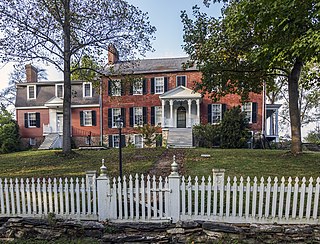
Hopewell is a set of historic homes and farm complexes located at Union Bridge, Carroll County, Maryland, United States. It consists of four related groupings of 19th century farm buildings. The Hopewell complex consists of two historic farms: Hopewell and the smaller F.R. Shriner Farm.
Wilson–Miller Farm is a historic home and farm located near Sharpsburg, Washington County, Maryland, United States. The house is a two-story, two-part, eight-bay log building resting on fieldstone foundations. The house features three brick chimneys, each painted red. Outbuildings include a one-story stone springhouse and a frame bank barn.

Hoffman Farm is a historic farm complex located at Keedysville, Washington County, Maryland, United States. It consists of an 1840s Greek Revival style two-story brick dwelling, adjacent brick slave quarters, a Federal-style stone house built about 1810 over a spring, a frame wagon shed, a log hog barn, and a frame forebay bank barn. The farm buildings were used as a hospital during the American Civil War in Battle of Antietam from the day of the battle on September 17, 1862, and through the following month. Over 800 men were hospitalized in the barn, house, outbuildings, and grounds.

The Willows is a historic farm complex located at Cavetown, Washington County, Maryland, United States. The farmhouse is a four bay long two-story Federal brick structure that is painted white. Also on the property are a one-story stone springhouse; a log pig house; a brick necessary; a stone smokehouse; "the old house," a former slave quarters; and two frame barns.
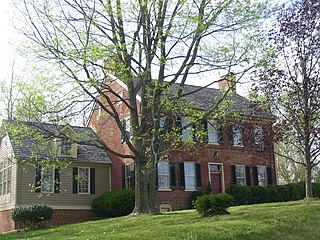
Appler-Englar House is a historic home located at New Windsor, Carroll County, Maryland. It is a two-story, five-by-two-bay brick dwelling constructed about 1790 in the Georgian style.
The William and Catherine Biggs Farm is a historic home and farm complex located at Detour, Carroll County, Maryland, United States. The complex consists of a stone house, a stone outbuilding / summer kitchen, a frame bank barn, and an early-20th-century concrete block barn, dairy building, and silo. The house is a two-story, five-by-two-bay structure with a three-by-two-bay, two-story rear wing. It is built primarily of rubble stone.

The Bennett-Kelly Farm is an historic home and farm complex located at Sykesville, Carroll County, Maryland, United States. The complex consists of a stone and frame house, a stone mounting block, a stone smokehouse, a frame bank barn, a frame wagon shed, a frame chicken house, a concrete block dairy or tool shed, and a stone spring house. The original mid-19th century stone section of the house is three bays wide and two stories high. The house features a one-bay Greek Revival pedimented portico with Doric columns. It is an example of a type of family farmstead that characterized rural agricultural Carroll County from the mid 19th century through the early 20th century.
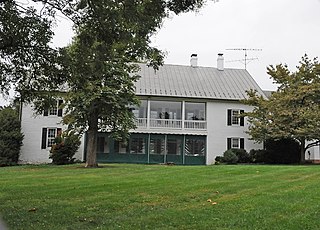
Friendship Valley Farm is a historic home and farm complex located at Westminster, Carroll County, Maryland, United States. It was established in the late 18th century. About that time a 2+1⁄2-story "T"-shaped main house was built of brick on a stone foundation. It was later expanded to its current "H" shape. One of the small log cabins still standing near the house was once a slave cabin. It was later used as a smoke house. Also on the property is a large brick wash-house and summer kitchen built in 1860, with a bell tower on the roof.

Mt. Pleasant, also known as the Clemson Family Farm, is a historic home located at Union Bridge, Carroll County, Maryland, United States. It is a five-bay by two-bay, 2+1⁄2-story brick structure with a gable roof and built about 1815. Also on the property is a brick wash house, a hewn mortised-and-tenoned-and-pegged timber-braced frame wagon shed flanked by corn cribs, and various other sheds and outbuildings. It was the home farm of the Farquhar family, prominent Quakers of Scotch-Irish descent who were primarily responsible for the establishment of the Pipe Creek Settlement.

The Stoner–Saum Farm is a historic home and farm complex located at Union Bridge, Carroll County, Maryland, United States. The complex consists of a brick house, a frame bank barn, a brick smokehouse, a stone ice house and summer kitchen, a stone wagon shed, and several other frame farm outbuildings. The house is a two-story, five-bay by two-bay structure with a rubble stone foundation.

Jacob F. Shaffer Farm is a historic home and farm complex located at Millers, Carroll County, Maryland. The complex consists of a brick house built in 1854, a rare stone bank barn, a frame summer kitchen, and a frame corn crib. The house is a two-story, three-bay wide, banked Federal / Greek Revival style brick structure with Flemish bond on the east-facing facade.
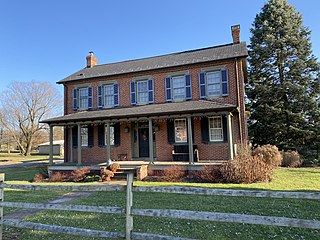
The Winemiller Family Farm is a historic home and farm complex located at Taneytown, Carroll County, Maryland, United States. The complex consists of a large two-story brick house built about 1865, a frame bank barn, and several outbuildings. It is a representative example of a type of family farm complex that characterized rural agricultural Carroll County from about 1850 through the early 20th century.
Keefer–Brubaker Farm, also known as the Oscar Fogle Farm, is a historic home and farm complex located at Taneytown, Carroll County, Maryland. It consists of a two-story six-by-two-bay log-and-frame house which is partially encased in brick and rests on a rubble stone foundation Also on the property is a frame summer kitchen, a combination smokehouse/dry house, a frame springhouse, a shop building, a bank barn, a dairy, a hog pen, a tool shed, poultry house, and several more recent buildings. It is a representative example of a family farm complex which spans the period from the late 18th century to the mid 20th century.
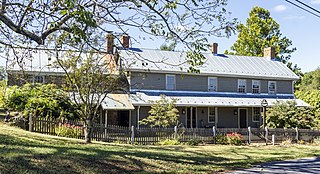
The McMurray–Frizzell–Aldridge Farm is a historic home and farm complex located at Westminster, Carroll County, Maryland, United States. It consists of a log house constructed about 1790 and later enlarged, and several 19th and early 20th century domestic and agricultural outbuildings, including a stone summer kitchen, a frame smokehouse, a frame bank barn, a frame wagon shed, a frame hog pen, and a stone spring house.
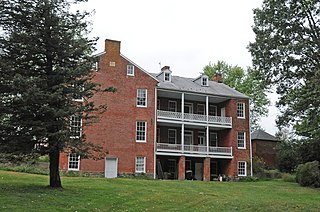
The John Orendorff Farm is a historic home and farm complex located at Westminster, Carroll County, Maryland, United States. The complex consists of a brick house, a brick privy, a brick smokehouse, a frame barn, a frame hog pen, a frame wagon shed, two poultry houses, and a feed house. The house is a five-by-two-bay brick structure, built in 1861 in the Italianate style. It has a 2+1⁄2-story, six-by-two-bay brick ell on the north side.

Rockland Farm is a historic home and farm complex located at Westminster, Carroll County, Maryland, United States. The complex consists of a brick house, the stone foundation of an 18th-century springhouse, as well as a large frame barn and a corn crib, both dating to the late 19th century. The house, built in 1795, retains the Pennsylvania German traditional three-room plan with a central chimney. It is a two-story, three-bay by two-bay brick structure on a stone foundation built into a slope.

Carroll County Almshouse and Farm, also known as the Carroll County Farm Museum, is a historic farm complex located at Westminster, Carroll County, Maryland. It consists of a complex of 15 buildings including the main house and dependencies. The 30-room brick main house was originally designed and constructed for use as the county almshouse. It is a long, three-story, rectangular structure, nine bays wide at the first- and second-floor levels of both front and rear façades. It features a simple frame cupola sheltering a farm bell. A separate two-story brick building with 14 rooms houses the original summer kitchen, wash room, and baking room, and may have once housed farm and domestic help. Also on the property is a brick, one-story dairy with a pyramidal roof dominated by a pointed finial of exaggerated height with Victorian Gothic "icing" decorating the eaves; a large frame and dressed stone bank barn; and a blacksmith's shop, spring house, smokehouse, ice house, and numerous other sheds and dependencies all used as a part of the working farm museum activities. The original Carroll County Almshouse was founded in 1852 and the Farm Museum was established in 1965.

Roop's Mill is a historic grist mill complex located near Westminster, Carroll County, Maryland. The complex includes a three-story, brick and stone mill, dating from about 1795 and rebuilt in 1816; the David Roop House, an 1825 stone dwelling; a log cooper's shed; an early two-part bank barn; numerous farm sheds; a late-19th century iron suspension bridge; and a bank barn dated to the 1860s. The brick mill was constructed according to the designs of Oliver Evans.





















